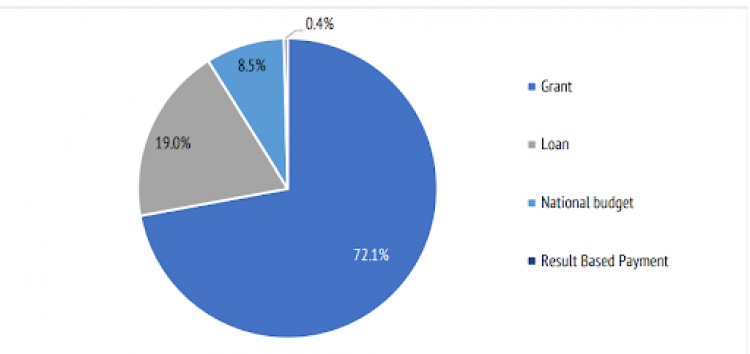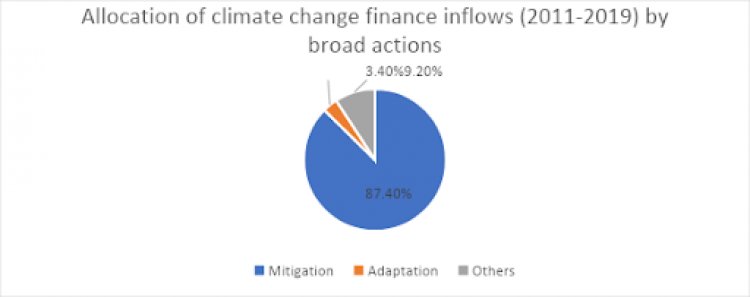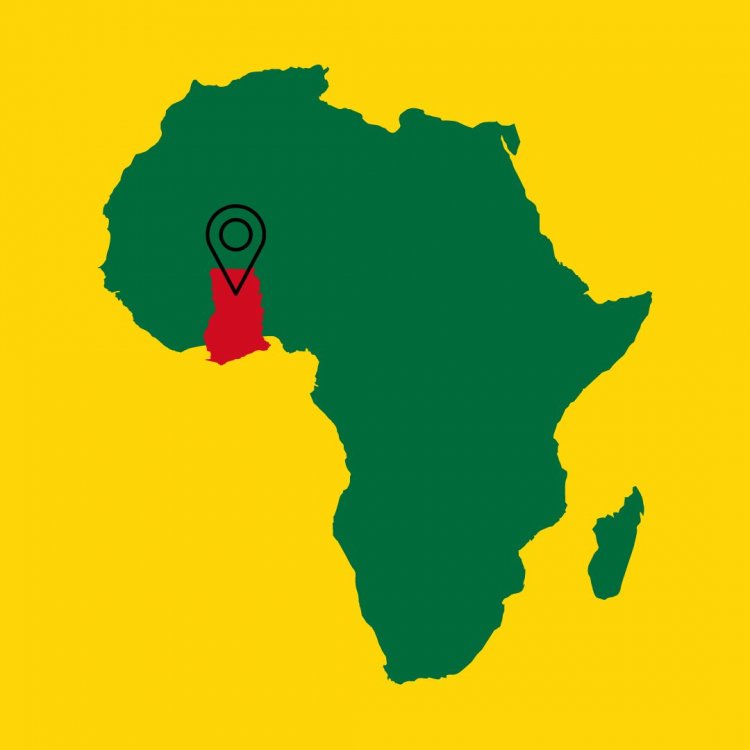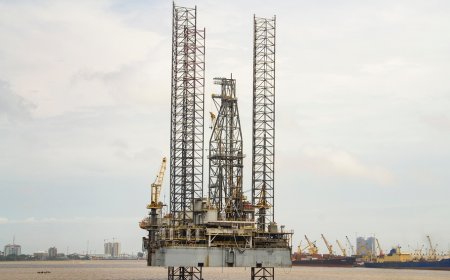Summary
Climate change is recognised as one of the key development risks of the 21st century. This paper presents a broad framing and overview of the key issues connected to climate action and adaptation in Ghana. It highlights issues of vulnerability, impacts and national response to climate actions. It identifies gaps and opportunities in the current climate action strategies, initiatives and practices to support policy makers and implementers with data and knowledge to develop and implement effective and sustainable adaptation. It thus also focuses on the need for Ghana to intensify adaptation efforts and pathways to instituting locally-led adaptation action.
1. Introduction and Country Background
Ghana is a lower-middle-income developing country with a land area of 238,000 square kilometres. It is bordered by Togo to the east, Cote d’Ivoire to the west and Burkina Faso to the north. According to the 2021 Census, the population of Ghana was 30.8 million (Ghana Statistical Service, 2021), 51% female, 49% male. By 2030, 37 million people are expected to live in the country. Ghana is divided into 16 regions and 261 local authorities or district assemblies. Its economy is dominated by the service sector, which contributes about 46% of GDP, followed by industry with 33% and agriculture with 21% of GDP. The key sectors driving the growth of the economy include the mining, petroleum, agriculture, and forestry sectors. The agricultural sector, however, is a key source of livelihood for the population. It employs the most people, accounting for at least 40 % of the country’s active labour force and about 71% of the rural population. Ghana’s long-term aspiration is to become a high-income country by 2056, and it plans to double per capita GDP in the medium term. However, climate change has been identified by policy makers as a key risk threatening to constrain these future aspirations.
2. Vulnerabilities and Impact of Climate Change
Ghana is ranked 109 out of 181 countries in the 2020 ND-GAIN Index.[1] A series of studies have revealed that climate change is having a growing impact on Ghana, hitting the poorest and vulnerable the hardest. It contributes to land degradation, biodiversity loss, water shortages, reduced food production, reduced economic growth, food insecurity, health risks and reduced agro-ecological productivity through rising temperatures and changing precipitation patterns.[2] [3] [4] Key climatic stressors are rising temperatures, reduced rainfall, incidences of weather extremes and disasters, drought-like conditions, and rising sea levels. Recent evidence suggests that the average number of hot nights in a year has increased by 73 (an extra 20% of nights), the average number of ‘hot’ days in a year has increased by 48 (an additional 13.2% of days) while the number of cold nights per year has fallen by 18.5 (5.1% of days) and the number of cold days per year has decreased by 12 (3.3% of days).[5] Extreme rainfall events have increased, and the average yearly temperature has risen by 1°C.
Vulnerability to climate change increases as one moves from the coast (tropical rainforest and coastal savannah zones) towards the transition zone (semi-deciduous forest and transitional zone) and northern savanna zones.[6] The savannah agro-ecologies, found especially in Northern Ghana, is the geographical zone most vulnerable to climate change. Rural areas are especially hit due to their heavy reliance on the agricultural sector. Staple crops, such as maize, cassava and millet, are traditionally rain-fed, and less than 1% of the national crop area is irrigated. Key vulnerable groups include fishing communities, small-scale farmers, cocoa farmers and general residents of formal and informal urban settlements. Women are especially vulnerable because they are often disadvantaged by traditional, patriarchal decision-making processes as well as by age, migrant status, limited access to land, type of household, livelihood orientation and inability to determine their adaptive options.[7] Their vulnerabilities and exposure to the impacts of climate change are also influenced by a mix of other multiple intersecting non-climatic processes. These processes, which include socioeconomic processes, livelihood changes and resource access, act together to amplify the risks and impacts of climate change.[8]
3. Status and Trends of Climate Action
Policies, Strategies, and Implementation Frameworks for Addressing Climate Change
Recognizing the critical importance of climate change risks to national development, the Ghanaian government has made considerable strides, through policies, programmes, and planning processes, to increase the country’s resilience to the negative impacts of climate change. Prominent programmes among Ghana’s adaptation policy initiatives include the National Climate Change Master Plan Action Programmes for Implementation (2015–2020), the Nationally Determined Contributions (NDC, 2015), the National Climate Change Policy (NCCP, 2013) and the National Climate Change Adaptation Strategy (NCCAS, 2012). Ghana has a National Adaptation Policy Framework, a key mechanism in strengthening its focus on adaptation.
Ghana’s NDC reaffirms its commitment to international climate change obligations under the Paris Agreement. It highlights country’s the long-term mitigation and adaptation goals and ways to provide synergistic avenues to reduce sector-wide vulnerabilities, build resilience and enhance overall efforts toward a green economy and climate-resilient sustainable development. The national response to climate change has revolved around a twin approach of lowering emissions and building a resilient society that can adequately withstand the impacts of climate change and contribute to mitigating global emissions. Available policy documents also highlight multi-dimensionality, coordination, and cross-scale approaches or strategies to tackle climate change—although these do not work effectively in practice, especially at the local level. Some of the key flagship public programmes and actions, at various stages of implementation, to mitigate and support adaptation include the following:
- Investing nearly US$ 670 million in seven sea defence projects along Ghana’s coastline over the last decade.
- Promulgating the Petroleum Exploration and Development Act, 2016, (Act 919) to restrict the flaring of gas in petroleum exploration and development.
- Committing The Forestry Commission to deliver six million tonnes of greenhouse gas emissions reduction under the Ghana Cocoa Forest REDD+ Programme with the World Bank in 2019
- Investing more than US$ 100 million since 2016 in the northern drylands to build the resilience of smallholder farmers and the fragile ecosystem they depend on for a livelihood
- City-wide resilient infrastructure planning, including an investment of US$ 200 million in the Greater Accra Resilient Integrated Development Project to improve flood risk and solid waste management in the Odaw River, led by the Ministry of Water Resources and Sanitation with funding from the World Bank
- Management of climate-induced and gender-related health risks
- Enhancement of climate education and climate services for efficient weather information management
- Early warning and disaster risk management
- Integrated water resources management
Governance of Climate Change
The current approach to climate adaptation planning in Ghana encourages cross-sectoral and inter-agency collaborative actions that integrate adaptation imperatives into policies, programmes and plans. As part of this process, a National Climate Change Committee (NCCC) has been created to provide the necessary strategic engagement, communication and coordination support systems across government ministries and sectors. Key government ministries such as Energy, Forestry, Agriculture, Health and Gender have also created Climate Change Units, which serve as channels for managing specific climate change issues in government ministries, departments and agencies (MDAs).
Trends and Overview of Climate Finance
Climate finance is generally difficult to track in Ghana for three reasons. First, several organizations in the country receive climate funding from diverse sources that do not always go through a central point such as the Ministry of Finance. Much of the funding to NGO civil society organisations is not reported to public agencies. Second, the communication between government and donors and other civil society organizations is generally poorly co-ordinated, leading to climate change interventions being duplicated. Third, it is difficult to monitor and report non-monetary support. However, evidence from public documents[9] on climate finance over the past decade reveals that financing is growing in Ghana, though it remains unequally distributed across different climate change actions.[10][11]
Total climate finance committed for the period 2011-2019 was approximately US$ 1.3 billion. That figure excluded climate related US$ 14.2 billion financial investment focused on developing the natural gas industry in three oil and gas fields. As shown in Fig. 1, 72.1% of the total amount of climate finance for the period was as grants. Other sources were loans (19.1%), national budget (8.5%) and result-based payments (0.4%).
Fig. 1: Climate Finance to Ghana (2011-2019) = $1,312,094,437

Source: Ghana Environmental Protection Agency (2020)
For the period 2011-2019, the leading recipient of climate financing, in terms of sectors, was energy. The total climate funds to the energy sector for the period amounted to US$ 758.8 million, 57.8% of total funds committed. The forestry sector was the second largest recipient. Both the energy and the forestry sectors strongly emphasized mitigation activities. Agriculture was the third biggest sector recipient. The preference appeared to be for big top-down projects, as opposed to local climate adaptation initiatives. The agriculture, forestry and other land use (AFOLU) sector, which is the largest emitter of greenhouse gasses and one of the most vulnerable sectors in the country, has received relatively less funding than, for example, the energy sector.
Fig. 2: Allocation of Climate Change Finance Inflows (2011-2019) by Broad Actions.

Source: Adapted from Ghana’s Fourth Communication Report (EPA, 2020).
As Figure 2 shows, mitigation is favoured over adaptation. Climate finance for mitigation activities constituted 87.4% of the total finance committed for the period, while adaptation activities took 3.4%. The remaining funds were committed to implementation activities, including capacity-building efforts.
4. Gaps and Shortcomings of Prevailing Climate Actions
Despite the progress on climate action in Ghana, the efforts underway still reveal gaps and shortcomings, which require attention. First, although Ghana has made some progress with adaptation planning, financing is limited. Ghana’s updated Nationally Determined Contribution (EPA and MESTI, 2021) requires between US$ 9.3 and US$ 15.5 billion of investment to implement the identified climate action measures from 2020 to 2030. Of that sum, US$ 3.9 billion is required until 2030 to implement the unconditional programmes of action, with the conditional programmes of action needing the remaining US$ 5.4 billion (expected to be mobilized from international, private sector sources, the public and carbon markets). The limited investment in this area constrains the efforts of adaptation projects to bring real protection against climate impacts such as droughts, floods, and sea-level rise. As the climate finance situation in Ghana shows, funding from 2011 to 2019 targeting adaptation was about twenty times less than the funding aimed at reducing emissions (mitigation).
Relatedly, climate finance has also not been reaching the local level as expected. Furthermore, there is still limited understanding of the differential impacts of climate change on adaptation options available to diverse vulnerable groups. Moreover, climate information and capacity development through education and early warning systems are also insufficient and not reaching vulnerable groups adequately enough to enhance their ability to cope and adapt their livelihoods.[12] There are also concerns that the analysis of vulnerability based on gender and other social and cultural factors is still poorly understood, limiting a better understanding of the differentiated impacts of climate change and the interaction of different adaptive strategies, for example, for women.[13] In addition, there is a limited understanding of the various mediating factors (e.g., lack of access to assets and social networks) that constrain locally driven or autonomous adaptation and limit potential benefits from planned adaptation actions.
Some studies also stress that, although local communities are already on the frontlines of climate change impacts, their voices and ideas are rarely sought or included in decisions that most affect them. Climate change decisions and planning are currently largely top-down, receiving less financing at the sub-national level, limiting the learning and various initiatives of mitigation and adaptation that are ongoing at the local level.[14],[15] Oduro et. al (2021) found that about half of the Climate Change Adaptation Programs of local authorities in Ghana outlined from 2013 to 2021 were never implemented and more than 70% have not been completely successful due to limited finance. A major knowledge gap also remains about the potential effectiveness and success factors of a wide range of initiatives on climate change. However, lessons from such initiatives could play a significant role in shaping successful pathways towards better adaptation. An understanding of the diverse needs, expectations and visions of communities is particularly insufficient and requires more attention to enable policymakers and project developers to address gaps and uncertainties on climate change and to create effective and sustainable pathways for adaptation initiatives.
5. Potential Role of Climate Adaptation and more Specifically Locally Directed/ Led Initiatives
As Ghana continues to develop new policies, strategies, and approaches to tackle climate change, investment into adaptation is critical. While finance for mitigation is important because it addresses the root cause of climate change, increased funding for adaptation is urgently required to support the efforts of people and communities already facing severe climate impacts. A fundamental pattern emerging across both the academic literature on climate adaptation and the country’s nascent body of practitioner experience shows that adaptation strategies are much more likely to be effective if developed in a manner cognizant of, and sensitive to, local conditions. [16] Recognition is increasing that it is the individual farmers, households and resource managers operating at the micro-level who are making most of the key land use and resource allocation decisions required for communities to adapt to the threats and opportunities posed by a changing climate.
As such, when adaptation responses are being formulated, the views and priorities of the local stakeholders who influence land, water, and other resource use decisions—which currently receive less attention—must be considered. For adaptation initiatives to be more successful, they must respond to distinct local and regional needs, vulnerabilities, coping strategies and adaptive capacities. Locally-led climate adaptation initiatives are especially important and, if well designed and implemented, they can prioritize life and livelihood needs by leveraging local resources, knowledge and practices, and potentially place power on local communities to influence adaptation efforts. International and national authorities should, therefore, entrust finances and delegate authority and power to local communities to use resources to protect themselves and build their resilience. Allowing local actors to lead climate adaptation is not only beneficial in environmental terms but can also deliver democratic, equitable and context-specific solutions.
6. Potential Role and Value of New Research to Enhance Adaptation Activities in Ghana
Given the shortcomings of the present approach to tackling climate change and the gaps exposed by the prevailing literature, Ghana’s adaptation processes must be enhanced by closing three important gaps:
- First, understanding must be deepened of narratives, visions, priorities, and expectations of climate adaptation initiatives at the local levels and how these are consistent with the priorities and actions of the government, civil society organisations and other actors at the forefront of climate change and its impacts. Such an understanding will inform policymakers to promote better adaptation initiatives for more effective and sustainable adaptation actions.
- Second, research into climate adaptation initiatives must be strengthened. There is currently limited documentation on their adaptive capacity, on what works and what does not work well and on their impacts, both positive and negative. This research will contribute to closing this gap through selected case studies of adaptation initiatives to tease out the barriers and core enabling factors that make adaptation initiatives successful or not, to learn and enhance Ghana’s adaptation effort.
- Third, understanding must be increased of Ghana’s progress towards implementing NDCs, the National Adaptation Plan and many of the priority actions highlighted in the various climate change policy documents. Light must be shed on the progress, successes and challenges associated with implementing the NDC and other adaptation initiatives in Ghana. Ultimately, this knowledge would support the work of policymakers, donor communities (especially those financing adaptation) and research and the academic community, as well as that of civil society organisations and Pan-African organisations promoting climate action in Ghana.
References
1. Notre Dame Global Adaptation Initiative. (2020). ND-GAIN country index. The University of Notre Dame.
2. World Bank (2021). Climate Risk Profile: The World Bank Group
3. Environmental Protection Agency (2020). Ghana’s Fourth National Communication to the United Nations Framework Convention on Climate Change. Available at: https://unfccc.int/sites/default/files/resource/Gh_NC4.pdf
4. Government of Ghana. (2018). Ghana’s National Adaptation Plan Framework. Environmental Protection Agency, Accra, Ghana.
5. EPA and MESTI (2021). Ghana’s Updated Nationally Determined Contribution under the Paris Agreement (2020-2030). Available at: https://mesti.gov.gh/documents/ghanas-updated-nationally-determined-contribution-unfccc_2021/
6. Antwi-Agyei, P., A. J. Dougill, L. C. Stringer and S. N. A. Codjoe (2018): Adaptation opportunities and maladaptive 31 outcomes in climate vulnerability hotspots of northern Ghana. Climate Risk Management, 19, 83-93, 32
7. Ahmed, A. et al. (2016): Adaptation to climate change or non-climatic stressors in semi-arid regions? Evidence of 29 gender differentiation in three agrarian districts of Ghana. Environmental Development, 20, 45-58, 30 doi:https://doi.org/10.1016/j.envdev.2016.08.002.
8. Antwi-Agyei, P., Dougill, A. J., & Abaidoo, R. C. (2021). Opportunities and barriers for using climate information for building resilient agricultural systems in Sudan savannah agro-ecological zone of north-eastern Ghana. Climate Services, 22, 100226
9. Government of Ghana. (2021). Ghana’s Adaptation Communication to the United Nations Framework Convention on Climate Change. Environmental Protection Agency, Accra, Ghana.
10. Ministry of Environment, Science, Technology and Innovation (MESTI, 2013). Ghana National Climate Change Policy. Available: https://www.un-page.org/files/public/ghanaclimatechangepolicy.pdf
11. The Ministry of Environment, Science, Technology, and Innovation (2015). Ghana National Climate Change Master Plan Action Programmes for Implementation: 2015–2020
12. Jaka, H. and E. Shava, 2018: Resilient rural women's livelihoods for poverty alleviation and economic empowerment in 39 semi-arid regions of Zimbabwe. Jamba, 10(1), 524, doi:10.4102/jamba.v10i1.524
13. EPA and MESTI (2021). Ghana’s Updated Nationally Determined Contribution under the Paris Agreement (2020-2030). Available at: https://mesti.gov.gh/documents/ghanas-updated-nationally-determined-contribution-unfccc_2021/
14. Oduro-Ofori, E., Isahaka, F., & Opoku-Antwi, G. (2021). Evidence of implementation of climate change adaptation programs by selected local governments in the Ashanti region, Ghana. GeoJournal, 1-17.
15. Antwi-Agyei, P., Dougill, A. J., & Abaidoo, R. C. (2021). Opportunities and barriers for using climate information for building resilient agricultural systems in Sudan savannah agro-ecological zone of north-eastern Ghana. Climate Services, 22, 100226.
16. World Bank (2021). Climate Risk Profile: The World Bank Group.
About the Author
Dr. Albert Arhin
Dr. Albert Arhin is the Lead Researcher for the project “Climate Adaptation Strategies and Initiatives: Issues and Pathways in Ghana”. Dr. Arhinis is a sustainability expert with more than fifteen years of experience in research, technical support and strategic planning in climate change, REDD+ and land restoration policies, green economy and sustainable development. He previously worked as a Research and Policy Manager for Oxfam in Ghana. He has also worked on multi-disciplinary projects designed to generate evidence to inform policy, practice and academic discourse. He was also a Research Fellow with the Bureau of Integrated Rural Development (BIRD) of the Kwame Nkrumah University of Science and Technology (KNUST), Ghana, and a lecturer at the Department of Planning, KNUST, Ghana. He holds a PhD in Geography from the University of Cambridge, UK.
Acknowledgements
The author would like to acknowledge and thank Dr. Olumide Abimbola (Executive Director, APRI) for overall guidance, Dr. Grace Mbungu (Senior Fellow and Head of Climate Change Program, APRI) for project leadership, and Bouchra Tafrata (Project Coordinator, APRI) for administrative support. Special thanks go to Zira John Quaghem for the helpful comments and feedback on the manuscript.




